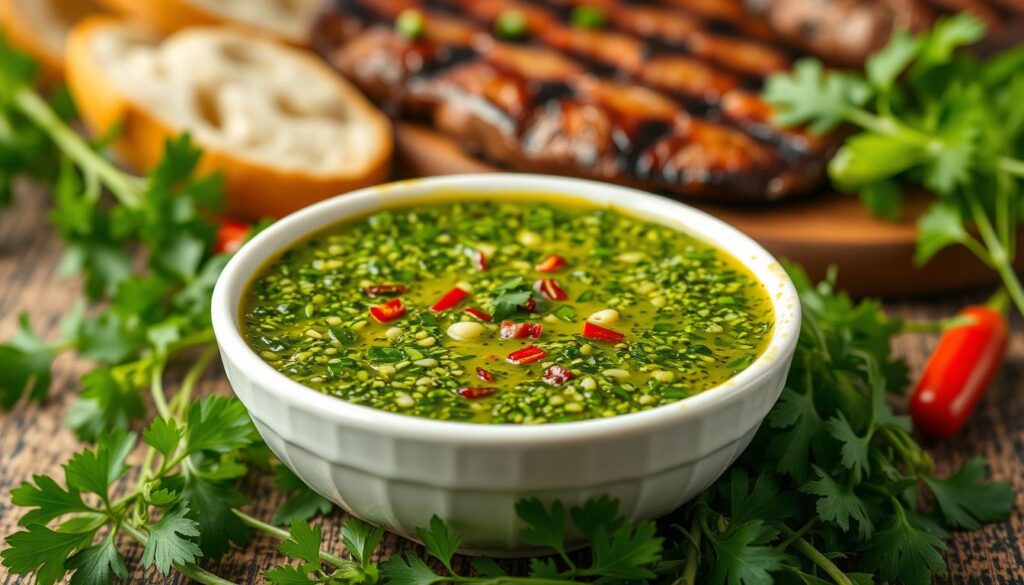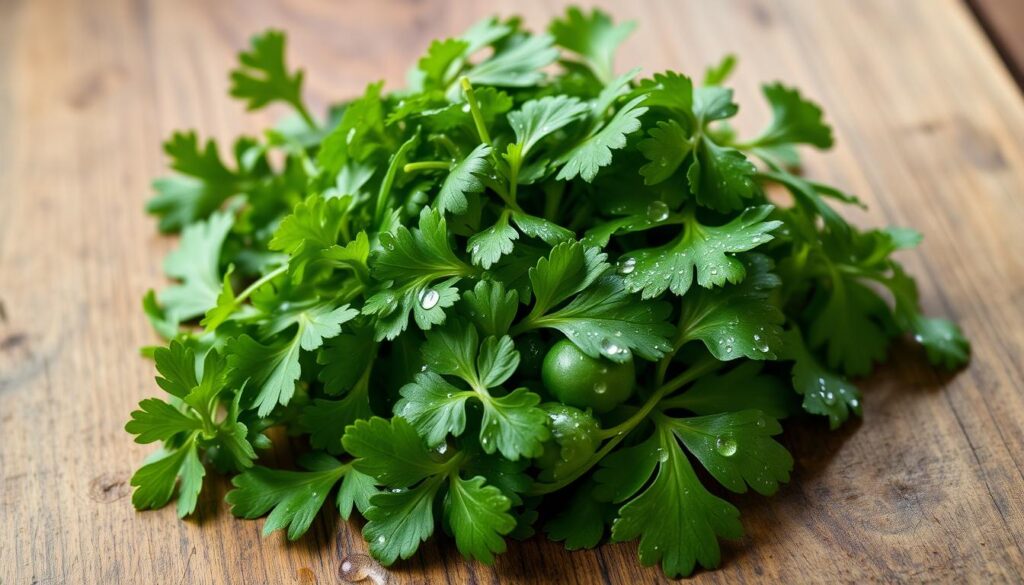The sizzle of a juicy steak on the grill reminds me of warm summer evenings in Buenos Aires. As the aroma of grilled meat filled the air, I’d watch my Argentine host prepare a vibrant green sauce. That sauce was chimichurri, and its fresh, zesty flavor captured my heart. Now, I’m excited to share this chimichurri sauce recipe with you, bringing a taste of Argentina to your kitchen.
This Argentinian condiment is a burst of flavor that elevates any dish. With just a handful of fresh ingredients, you can create this versatile herb sauce in minutes. Whether you’re a seasoned chef or a kitchen novice, this recipe will guide you through crafting an authentic chimichurri that pairs perfectly with grilled meats and vegetables.
Chimichurri is more than just a sauce; it’s a celebration of simplicity and freshness. The bright green hue comes from parsley, the backbone of this recipe. Garlic adds a pungent kick, while a blend of herbs creates a complex flavor profile that dances on your tongue. Get ready to embark on a culinary journey that will transport your taste buds to the heart of Argentina.
Table of Contents
Understanding Traditional Argentine Chimichurri
Chimichurri is a key part of South American food, especially in Argentina. It’s a green sauce known for its bold taste and how it can be used in many ways.
Origins and Cultural Significance
The story of chimichurri’s start is a bit fuzzy, but it’s thought to have been made by Argentine cowboys in the 19th century. They used it to add flavor to their grilled meats while they were on long cattle drives in the Pampas grasslands.

Regional Variations Across South America
Chimichurri is mainly from Argentina, but other countries have their own twists. In Uruguay, they add carrots and red peppers. Brazil might use cilantro, and Paraguay sometimes includes bell peppers.
Traditional Uses and Serving Suggestions
Chimichurri is perfect with grilled meats, especially beef. It can be brushed on before grilling, used as a marinade, or served on the side. You’ll see it on choripán (grilled chorizo sandwiches) or with empanadas in Argentine restaurants.
- Baste on steaks during grilling
- Marinate chicken or fish
- Toss with roasted vegetables
- Spread on crusty bread
Exploring chimichurri shows how versatile it is, making dishes more than just grilled meats. This sauce truly captures the essence of South American food.
Essential Ingredients for Authentic Chimichurri Sauce Recipe
Making a tasty chimichurri sauce begins with picking the right ingredients. This sauce needs fresh herbs and a mix of flavors. Let’s look at the main parts that make this sauce so good.
Fresh Herbs Selection Guide
The heart of chimichurri is its herbs. Go for fresh parsley and oregano for the best taste. Use flat-leaf parsley for its strong flavor. Keep a 2:1 ratio of parsley to oregano.

Choosing the Right Vinegar
Red wine vinegar is the classic choice for chimichurri. It adds a tangy taste that matches the herbs well. If you can’t find red wine vinegar, white wine vinegar is okay. But, avoid balsamic or apple cider vinegar as they can hide the herb flavors.
Oil and Seasoning Components
Extra virgin olive oil forms the foundation of this sauce. It holds everything together and adds depth. For extra flavor, add minced garlic, red pepper flakes, and salt.
| Ingredient | Amount | Notes |
|---|---|---|
| Parsley | 2 cups | Finely chopped |
| Oregano | 1/4 cup | Fresh, chopped |
| Garlic | 4 cloves | Minced |
| Red Wine Vinegar | 1/4 cup | High-quality |
| Olive Oil | 3/4 cup | Extra virgin |
| Red Pepper Flakes | 1 tsp | Adjust to taste |
| Salt | 1 tsp | To taste |
With these ingredients, you’re set to make a real Argentine chimichurri sauce. It will make any dish better.
Kitchen Tools and Equipment Needed
Making the perfect chimichurri sauce recipe needs the right tools. This herb sauce requires precision and care. So, having the right kitchen tools is essential.

- Sharp chef’s knife
- Sturdy cutting board
- Large mixing bowl
- Measuring spoons and cups
- Whisk or fork for blending
- Airtight storage container
A sharp knife is key for chopping herbs finely without bruising them. Choose a non-reactive mixing bowl, like glass or stainless steel. This prevents unwanted flavors from getting into your sauce.
| Tool | Purpose | Recommended Material |
|---|---|---|
| Chef’s Knife | Chopping herbs | Stainless steel |
| Cutting Board | Prep surface | Wood or plastic |
| Mixing Bowl | Combining ingredients | Glass or stainless steel |
| Storage Container | Preserving sauce | Glass with tight-fitting lid |
Quality tools make the process smoother and can improve your chimichurri sauce recipe. Invest in durable equipment. This way, your herb sauce will be perfect every time.
Step-by-Step Preparation Method
Making the perfect chimichurri sauce is an art. It mixes fresh ingredients with careful steps. Let’s explore how to make this tasty parsley vinaigrette.
Herb Preparation Techniques
Begin by washing and drying your herbs well. For the best sauce, chop parsley and oregano by hand. This keeps their oils and gives a rustic feel. Try for small cuts, but don’t make them too fine.
Mixing and Blending Instructions
In a bowl, mix your chopped herbs with minced garlic, red pepper flakes, and salt. Slowly add red wine vinegar and olive oil, stirring gently. This slow mix helps the flavors blend well.
Achieving Perfect Consistency
The perfect chimichurri sauce has a bit of chunkiness. Don’t over-mix, or it will become too smooth. Allow it to rest for approximately 15 minutes before serving. This lets the flavors fully develop.
“The secret to a great chimichurri is in the balance of flavors and textures. It should be vibrant and full of character.”
Your chimichurri sauce should look like a colorful, herb-filled dressing. It’s now ready to make your grilled meats taste better or as a zesty dressing for salads.
Storage Tips and Shelf Life
Keeping your chimichurri sauce fresh is important. It lets you enjoy its flavors for days or weeks. The right storage keeps it tasting great.
Proper Container Selection
Use airtight glass jars or containers for your chimichurri sauce. Glass doesn’t absorb flavors and keeps it fresh. Stay away from plastic containers as they can hold smells and change taste.
Refrigeration Guidelines
Always put your chimichurri sauce in the fridge. Keep it at 40°F (4°C) or below to stop bacteria from growing. Keep it stored at the back of the fridge, where the temperature is the coolest.
Signs of Freshness
Fresh chimichurri sauce looks vibrant green and smells strong. If it turns brown, smells bad, or has mold, throw it away. Homemade chimichurri usually lasts 1-2 weeks when stored right.
| Storage Method | Shelf Life | Best Practices |
|---|---|---|
| Refrigeration | 1-2 weeks | Use clean utensils, keep lid tight |
| Freezing | Up to 3 months | Freeze in ice cube trays for portion control |
| Room Temperature | 2-3 hours | Only for serving, return to fridge promptly |
Follow these tips to keep your chimichurri sauce fresh. You’ll enjoy its authentic Argentinian taste for longer.
Pairing Suggestions with Different Meats
Chimichurri sauce is a versatile steak sauce that pairs wonderfully with various grilled meats. This Argentine classic elevates the flavors of your favorite cuts, making it an essential grilled meat accompaniment.
For beef lovers, chimichurri shines brightest. Drizzle it over a juicy ribeye or sirloin for a burst of herbaceous goodness. The sauce’s acidity cuts through the richness of the meat, creating a perfect balance.
Pork also benefits from chimichurri’s zesty profile. Try it with grilled pork chops or tenderloin to add a fresh, tangy dimension to the meat’s natural sweetness.
Don’t overlook chicken! Chimichurri brings life to grilled chicken breasts or thighs, infusing them with vibrant flavors. It’s a great way to spice up your poultry dishes.
For lamb enthusiasts, chimichurri offers a delightful contrast. The sauce’s bold flavors complement the gamey notes of grilled lamb chops or leg of lamb beautifully.
| Meat | Cut | Pairing Suggestion |
|---|---|---|
| Beef | Ribeye, Sirloin | Drizzle liberally over the steak |
| Pork | Chops, Tenderloin | Serve as a side dipping sauce |
| Chicken | Breasts, Thighs | Brush on during grilling |
| Lamb | Chops, Leg | Spoon over just before serving |
Remember, chimichurri isn’t just for red meat. Its versatility as a grilled meat accompaniment makes it perfect for your next barbecue, no matter what’s on the menu.
Common Mistakes to Avoid
Making the perfect chimichurri sauce can be tricky. Let’s look at some common mistakes and how to avoid them. This way, you’ll always have a delicious herb sauce.
Ingredient Proportions
One common mistake is getting the ingredient ratios wrong. Too much vinegar can overpower the herbs. On the other hand, too much oil can dilute the flavor.
Try to keep a balance of 2 parts oil to 1 part vinegar. Make sure to add plenty of fresh herbs. This will help you create a vibrant chimichurri sauce.
Processing Methods
Don’t over-process your chimichurri. Blending the herbs too much can turn your sauce into a paste. This loses the texture you want.
Instead, chop the herbs by hand or pulse them briefly in a food processor. This will give you the best results.
Storage Errors
Proper storage is key to keeping your herb sauce fresh. Don’t leave chimichurri at room temperature for too long. Store it in an airtight container in the refrigerator.
It can keep fresh for up to a week in the fridge. Remember to let it reach room temperature for the best flavor. This will bring out the best flavor.
By avoiding these common mistakes, you’ll become a pro at making authentic chimichurri sauce. Enjoy it with grilled meats or as a zesty dip!
Variations and Modern Twists
Chimichurri sauce recipe fans are always eager to try new twists. The classic version is loved, but creative cooks have come up with exciting changes. These updates give this South American staple a fresh spin.
Spicy Chimichurri Version
For those who love a little heat, spicy chimichurri is ideal. Add red pepper flakes or finely chopped jalapeños to the basic recipe. Some chefs even use habanero peppers for an extra kick.
This spicy version is great with grilled meats. It adds a zesty flavor to your barbecue.
Herb Substitutions
Trying different herbs can create unique tastes in your chimichurri sauce. While parsley and oregano are traditional, cilantro gives it a Mexican twist. Mint adds a refreshing touch, perfect for lamb.
Basil or thyme can give it an Italian flavor. These herb swaps let you customize the sauce for different dishes or tastes.
The secret to great chimichurri variations is keeping the flavors balanced. Whether you’re adding heat or changing herbs, stay true to the sauce’s essence. Your creativity can make this timeless recipe a versatile kitchen staple.

